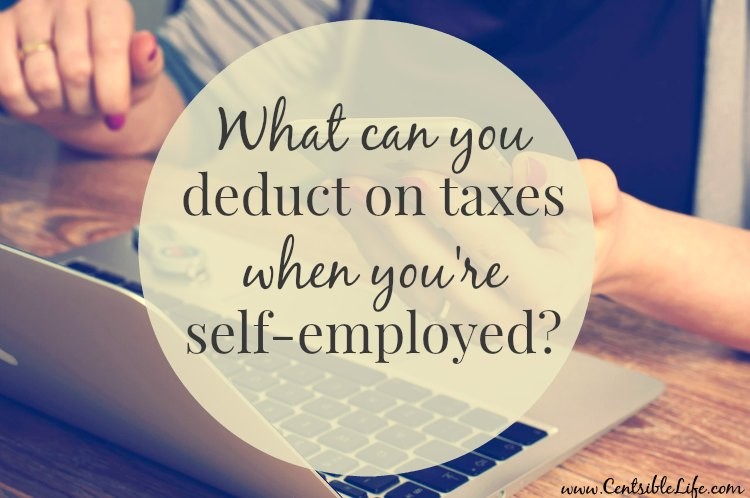Self-employed folks like me dread tax time for the most part. When your income fluctuates it can hard to pin down exactly how much you owe in taxes. It’s also a big job to track your expenses and what you can deduct on your tax return. It can all be rather confusing if you try to file on your own, but there are some often overlooked deductions you should consider below.
Note: Please consult with a tax professional if you have specific questions about tax deductions. This information is meant for educational purposes, and does not constitute professional advice.

Self-Employment Tax
To start let’s talk about self-employment tax. Self-employed people pay taxes that most corporate workers have removed for them before they see their income. We pay 15.3% of our income in taxes-12.4% for social security (old-age, survivors, and disability insurance) and 2.9% for Medicare (hospital insurance) up to $117,000 (for 2014). Some businesses require other taxes as well, and the state your business operates in may also require additional taxes.
The good news is you can claim 50% of your self-employment tax as a deduction on your tax return. Essentially you pay your taxes and receive a deduction on what you owe. This can be beneficial if your income fluctuates (which is the case for most self-employed people), and it takes the sting off paying those taxes just a bit.
Tracking Expenses
In addition, to paying taxes you wouldn’t as a salaried or hourly worker we’re also responsible for tracking and accounting for expenses related to our business. In most cases a salary or hourly worker won’t have any business related deductions since your employer provides you equipment and will often pay for training, conferences, and the like.
The easiest way to track your expenses is to keep separate bank accounts, PayPal accounts, and a credit card (or cards) for your business. This will allow for easier bookkeeping each month (or if you put it off for the year).
I use an income and expense tracker I created (you can find it here), but you can simply use year-end statements, a service like Quicken for business, or a myriad of other accounting options.
List Of Potential Tax Deductions For Self-Employed
There are a multitude of deductions you can take that vary greatly based on the type of business you own. For example, if your business is related to photography you can deduct new photography equipment or if your business is related to driving (such as an errand business) you may be able to deduct expenses related to owning a business vehicle. Since a small business often has unique questions it is best to discuss possible deductions with a tax advisor or attorney.
Below you’ll find some of the most common (and a few not so common) tax deductions for self-employed workers.
lflf-employment Tax Deduction: 50% of you self-employment taxes owed are tax-deductible.
Home Office deduction: Only the part of the home you use for an office, must have a door, can only be used as an office, it is considered a red flag for audits so be careful.
Health Insurance Premiums: If your insurance is not provided by another employer and you pay for it yourself you can deduct your health insurance premiums.
Meals & Entertainment: When you travel (and in some cases locally) you can debut meals and entertainment at 50% of the cost. Keep detailed records including receipts and be sure to include tip and tax in that 50%. These need to be reasonable, so no $1,000 bottles of wine. If you don’t have detailed records you can take a per diem (per day) cost.
Travel Expenses: Travel costs that are necessary for work such as a plane ticket to attend a conference, hotel room fees while you travel, and more are included. This includes train or airplane tickets, shuttle or taxicabs, Uber or Lift, rental cars, hotel room charges, etc.
Gas Mileage And Tolls: You can also deduct expenses related to driving for work including to and from events, to and from airport, etc. Be sure to keep detailed records of your mileage for this purpose.
Utilities: Internet, phone, potentially cable, electricity, and more. Based on the percentage used for business if you work from home. If you have a cable bundle for instance you can deduct the portion you use for business. That may look like 2/3 the costs (phone and internet) and 50% of that amount (if used 50% for business and 50% for personal use).
Education: Publications, books, conference tickets-anything that helps you further your business and education apply.
Equipment And Supplies: Including items like envelopes, stamps, printer ink, and tech like computers or tablets.
Advertising: Advertising your business through ads, etc.
Self-Employed Retirement Plans: Self-employed retirement plans including SEP IRAs and 401ks.
This is not an exhaustive list of deductions, but it will help you get started. Remember that your business is unique and you need to consider the advice of a professional when it comes to tax season. DIY taxes are great for those with straightforward taxes, but in most cases you’ll benefit greatly from talking to someone who is well versed in tax needs for small businesses.
Note: Please consult with a tax professional if you have specific questions about tax deductions. This information is meant for educational purposes, and does not constitute professional advice.
Kelly
Share your thoughts!